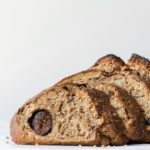fig and anise wheat bread
This hearty fig and anise bread is filled with the honeyed flavor of dried figs, sweet undertones of anise and chewy specks of bulgar. The crust is thick and crunchy (don’t skip the steam in the oven!) and absolutely addictive with a pat of melting butter.
- Prep Time: 20 hours
- Cook Time: 40 minutes
- Total Time: 20 hours 40 minutes
- Yield: 2
- Category: Bread
- Cuisine: American
Ingredients
preferment
- 1 cup + 1 tablespoon all-purpose flour
- 6 tbsp white whole wheat flour (or whole wheat flour)
- 1/2 cup lukewarm water
- 1 tbsp ripe (fed) sourdough starter or 1/4 tsp instant yeast (active dry works fine as well)
soaker
- 6 tbsp water
- 1/2 cup + 1 tbsp cracked wheat
dough
- 1 3/4 cups white whole wheat flour (or whole wheat flour)
- 1 cup all-purpose flour
- 1 tsp instant yeast (active dry works fine as well)
- 1 scant cup room-temperature water (about 70°F)
- all of the preferment (above)
- a scant 2 1/2 tsp salt
- all of the soaker (above)
- 7 oz (about 1 1/4 cup) dried Mission figs, stemmed and chopped slightly larger than marble size (if very dry, soak in boiling water for 30 minutes)
- 1 1/2 tsp anise seed, toasted in a skillet until lightly browned
Instructions
preferment
- Mix the flour, water, and sourdough starter until thoroughly combined. Cover with plastic wrap and let rest at room temperature for 12 to 16 hours; the dough will be nice and bubbly (as much as 24 hours ahead works fine).
soaker
- Toast the cracked wheat in a skillet set over low heat until the grains are lightly browned, and smell toasty. Combine the wheat and water, and let rest overnight.
dough
- In a large bowl, combine the flours and yeast, then stir in the water, mixing until no dry bits remain. If you're using a stand mixer, this may take up to 3 to 4 minutes at low speed.
- Let the dough rest in the bowl, covered, for 20 minutes.
- Add the preferment, soaker, and salt, mixing until fully incorporated. Mix for 6 to 7 minutes at medium-low speed; the dough should be smooth (aside from the cracked wheat) and elastic.
- Add the fig and anise seed, mixing on low speed until evenly distributed. The dough may be quite stiff; that's OK. (It may feel impossible that you’ll incorporate the figs, especially if you soaked them and they’re slippery, but stick with it and they’ll knead in eventually. Sometimes, I stop the machine and knead the dough by hand a few times to tuck any lose figs into the dough, then start it again at low speed).
- Check the dough temperature; it should be between 75°F and 80°F. This is the optimum temperature for rising dough, so try to find a spot that's around that temperature.
- Cover the bowl, and let the dough rise for 15 minutes. Give the dough its first fold by reaching into the bowl and pulling a corner of dough up, folding it back toward the middle, and pushing it down. Repeat, working your way around the dough ball, for a total of 4 to 6 times. This will both de-gas the dough, helping the yeast to work; and strengthen the dough's structure.
- Repeat folding the dough after another 15 minutes (at the 30-minute mark since it started rising), and once more at the 45-minute mark.
- Let the dough rise for 90 to 120 minutes, or until it's noticeably puffy, though perhaps not doubled in bulk.
- Gently deflate the dough, and divide it into two pieces about 560g each. Gently pre-shape the pieces by gathering the corners of the dough and folding them to the center to form a loose ball. Place the balls, seam-side down, on a very lightly floured surface, cover, and let rest for 10 to 15 minutes.
- Working with one piece of dough at a time, shape as a batard with tapered points. Tuck one end underneath to create a teardrop shape. Place seam-side up on a flour-dusted couche or smooth cotton towel. Repeat with the second piece of dough. Need help shaping? See our tips for shaping a batard video. (Alternatively, shape into two balls like I did).
- Gently cover the loaves, and let them rise for about 60 minutes, until they're puffy. While the loaves are rising, preheat your oven to 450°F, with a baking stone on the middle rack. Place a cast iron pan on the oven's lowest rack; you'll use it to create steam.
- To bake on a stone: Roll the proofed loaves, seam-side down, onto a peel dusted with semolina or whole wheat flour. If you aren't using a stone, roll them onto a parchment-lined baking sheet, seam-side down.
- Score the dough with a baker's lame or very sharp knife, cutting an arc from the midpoint of the tip to the midpoint of the base.
- Add 1 cup boiling water to the cast iron pan. Quickly use the peel to load the loaves onto the stone (or place the pan in the oven), and close the door.
- Bake the loaves for 32 to 37 minutes, or until they're a rich mahogany color. The top crust will feel firm, and the bottom crust will be robust, but not burned. If you have a digital thermometer, the loaf's center temperature should be about 200°F.
- Remove the loaves from the oven, and transfer them to a rack to cool.
Notes
makes 2 loaves | recipe from King Arthur Flour
Nutrition
- Serving Size: 1/6th of loaf
- Calories: 130
- Sugar: 2.8g
- Sodium: 487mg
- Fat: 0.8g
- Saturated Fat: 0.1g
- Unsaturated Fat: 0.4g
- Trans Fat: 0g
- Carbohydrates: 28g
- Fiber: 3.3g
- Protein: 4.4g
- Cholesterol: 0mg
Find it online: https://www.withspice.com/blog/fig-and-anise-wheat-bread/
